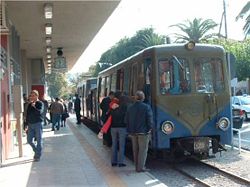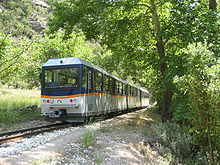- Diakofto–Kalavryta Railway
-
The Diakofto–Kalavryta Railway is a historic 750 mm (2 ft 5 1⁄2 in) gauge rack railway in Greece. Located on the northern Peloponnese, it runs 22 km from Diakofto through the Vouraikos Gorge and the old Mega Spilaion Monastery and up to Kalavryta, stopping en route at Zachlorou.[1]
The line was built by the Piraeus, Athens and Peloponnese Railways (SPAP). Currently the infrastructure and rolling stock are owned and maintained by Hellenic Railways Organisation (OSE). Passenger trains are operated by TrainOSE.[2]
Contents
Technical information
The railway is single line with 750 mm (2 ft 5 1⁄2 in) gauge. It climbs from sea level to 720 m in 22.3 km with a maximum gradient of 17.5%. There are three sections with Abt system rack for a total of 3.8 km. Maximum speed is 40 km/h for adhesion sections and 12 km/h for rack sections.[3]
There are bridges over Vouraikos River at many locations and numerous tunnels. Passing loops exist at Niamata, Triklia, Zachlorou and Kerpini.
Rolling stock sheds and maintenance facilities are located at Diakofto. Additional facilities existed at Kalavrita station during the steam era but they are no longer in use.
The line was to be electrified and EMUs were ordered at Billard, France. Before the cars arrived, the plans for electrification were scrapped, the EMUs were thus not usable when they arrived. As a makeshift solution a power car carrying a diesel generator was placed in the middle of the two cars. This solution has worked very well for decades.
Current status and timetables
OSE recently completed renovation work on the northern part of the line (major maintenance of bridges, enlargement of tunnels, replacement of the rack and testing of new rolling stock), during which the line was wholly or partly closed.[4] Currently (November 2009) there is a limited service on weekdays with three trains on each direction and an extended service on weekends and public holidays with two additional trains.
Departures from Diakopto are at 08:10, 11:15 and 14:12 (Monday through Friday), 08:10, 11:15, 12:33, 14:12 and 15:32 (weekends). Return trips from Kalavrita depart at 09:28, 12:27, 15:30 (Monday through Friday), 09:28, 12:27, 14:10, 15:30 and 16:50 (weekends).[5]
Rolling stock
Steam locomotives
Six steam locomotives were constructed specifically for this line, on a basic design by Cail (1891).[6]
Locomotive Type Supplier Year Notes ΔΚ1
ΔΚ-80010-6-2RT Cail 1891 Preserved in good condition at Kalavryta ΔΚ2 0-6-2RT Cail 1891 ΔΚ3
ΔΚ-80030-6-2RT Cail 1891 Displayed on a plinth at Diakofto ΔΚ4 0-6-2RT Cail 1891 Displayed at the Railway Museum of Athens. ΔΚ11 0-6-2RT Krupp 1891 Boiler with superheater ΔΚ-8005 0-6-2RT SPAP Piraeus Works 1954 Diesel trainsets
The first batch of modern rolling stock for the Diakofto-Kalavryta railway consists of three diesel-electric trainsets (Class 3001) built by Billard in 1958. They were numbered ΑΔΚ 01 to ΑΔΚ 03, later renumbered as ΑΒδφπτ 3001 to ΑΒδφπτ 3003. Three similar trainsets (Class 3004) built by Decauville were added in 1967. They were numbered ΑΒδφπτ 3004 to ΑΒδφπτ 3006. These trainsets, both types of similar configuration, consist of two passenger cars (a motor car and a control car) and a generator trailer or "OPE" (Greek: ΟΠΕ) between them. In addition, a steam locomotive (ΔΚ 8001, delivered by Cail in 1891) is preserved at Kalavryta station and has been used occasionally for special trains.[7]
Four new three-car diesel-electric trainsets were ordered from Stadler Rail to replace the old rolling stock and entered service in 2009.[8] These are designated as Class 3107.[9]
Train Supplier Year Railcars 3001 Billard 1958 3001+OPE3501+3001 3002 Billard 1958 3002+OPE3502+3002 3003 Billard 1958 3003+OPE3503 3004 Decauville 1967 3004+OPE3504+3004 3005 Decauville 1967 3005+OPE3505+3005 3006 Decauville 1967 3006+OPE3506+3006 3107 Stadler 2009 3107+3507+3207 3108 Stadler 2009 3108+3508+3208 3109 Stadler 2009 3109+3509+3209 3110 Stadler 2009 3110+3510+3210 References
- ^ "Diakofto Kalavrita Railway". IgoUgo. http://www.igougo.com/planning/journalEntryActivity.asp?EntryID=4155. Retrieved April 24, 2006.
- ^ Network Statement 2007PDF (1.29 MB). EDISY S.A., Athens, 2006.
- ^ H. Pyrgidis (in Greek). Railway Transportation Systems (Greek: Συστήματα Σιδηροδρομικών Μεταφορών). Thessaloniki, Greece: Zitis. pp. 702. ISBN 978-960-456-155-1.
- ^ "Diakopto - Kalabryta project". Organismós Sidirodrómon Elládos (in Greek). http://www.ose.gr/ose/content/Document.aspx?d=40&rd=16506950&f=-1&rf=-1&m=5557&rm=20544871&l=2. Retrieved March 29, 2008.[dead link]
- ^ TrainOSE S.A. "Timetables 1 August 2009", Table 11; see Wimikedia Commons for train graphs
- ^ Organ, J. (2006). Greece Narrow Gauge. Middleton Press. ISBN 1-904474-72-1.
- ^ Simms, W.F. (1997). The railways of Greece. Wilfried F. Sims. pp. 55. ISBN 0-9528881-1-4.
- ^ "Diesel electric BDmh 2Z+4A/12 Rack-wheel train for the Hellenic Railways Organisation S.A. (OSE), Greece" (PDF). Stadler Bussnang AG. http://www.stadlerrail.com/media/uploads/factsheets/ZB_OSE_ZR_e_neu.pdf. Retrieved 2010-10-06.
- ^ "References: Hellenic Railways Organisation (OSE), Greece". Stadler Rail. http://www.stadlerrail.com/en/references/griechische-staatsbahnen-ose-griechenland/. Retrieved 2010-10-06.
ITINERARIES rack railway Diakopto-Kalavrita
From Diakopto 08:45 - Daily 11:15 - Daily 12:33 - Weekends 14:32 - Daily 15:50 - Weekends
From Kalavrita 09:57 -Daily 12:27 - Daily 14:30 - Weekends 15:50 - Daily 17:50 - Weekends
Further reading
- J.H. Price (September 1962). "Day trip to Kalavryta". The Railway Magazine (London, UK: Toothill Press Ltd.) 108 (737): 642–645.
- Kalvryta guide
- Attractions in Kalavryta
- "Οδοντωτός (Odontotos)". http://www.odontotos.com.webpage about Diakofto-Kalavryta railway (Greek and English)
- "Organismós Sidirodrómon Elládos". http://www.ose.gr/ose/content/Home.aspx?d=39&rd=16685622&f=-1&rf=-1&m=-1&rm=-1&l=1. Main website of OSE (in English)
- "Trip description". http://www.theplaka.com/kalavryta/getthere.htm.
- Kalavryta guide
- www.ediakopto.gr-Guide of Diakopto/Diakofto
Categories:- Mountain railways
- Heritage railways of Greece
- Rack railways in Greece
- 760 mm gauge railways
Wikimedia Foundation. 2010.



